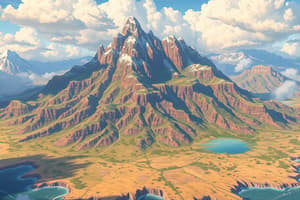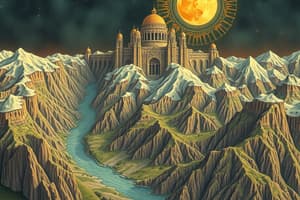Podcast
Questions and Answers
Which of the following best describes the origin of mountains in physical geography?
Which of the following best describes the origin of mountains in physical geography?
What is the primary difference between climate and weather?
What is the primary difference between climate and weather?
Which factor does NOT influence climate according to physical geography?
Which factor does NOT influence climate according to physical geography?
What type of soil is characterized by high drainage and low nutrient retention?
What type of soil is characterized by high drainage and low nutrient retention?
Signup and view all the answers
Which of the following biomes is primarily characterized by low rainfall and extreme temperatures?
Which of the following biomes is primarily characterized by low rainfall and extreme temperatures?
Signup and view all the answers
What is the term used to describe the study of water in the environment?
What is the term used to describe the study of water in the environment?
Signup and view all the answers
Which of the following natural hazards is directly related to geological activity?
Which of the following natural hazards is directly related to geological activity?
Signup and view all the answers
Which key concept involves the interactions between organisms and their non-living environment?
Which key concept involves the interactions between organisms and their non-living environment?
Signup and view all the answers
Study Notes
Physical Geography
Definition
- Branch of geography focused on the natural environment and its processes.
Major Components
-
Landforms
- Mountains: Elevated areas, created by tectonic forces (e.g., Himalayas).
- Valleys: Low areas between hills or mountains, often formed by erosion.
- Plateaus: Elevated flatlands, often with steep sides (e.g., Colorado Plateau).
- Plains: Flat or gently rolling areas, typically fertile for agriculture.
-
Climate and Weather
- Climate: Long-term atmospheric conditions in a region (e.g., tropical, arid).
- Weather: Short-term atmospheric conditions (e.g., temperature, precipitation).
- Factors influencing climate:
- Latitude: Affects temperature and sunlight.
- Elevation: Higher altitudes generally cooler.
- Proximity to water: Influences humidity and precipitation patterns.
-
Soils
- Types of soil (e.g., sandy, clay, loamy).
- Soil formation processes (weathering, organic matter accumulation).
- Importance for agriculture, ecosystems, and biodiversity.
-
Biogeography
- Distribution of ecosystems and organisms across the planet.
- Influenced by climate, geography, and human activity.
- Notable biomes: deserts, forests, grasslands, tundras.
-
Hydrology
- Study of water in the environment (surface water, groundwater).
- Water cycle: Evaporation, condensation, precipitation, infiltration.
- Importance of rivers, lakes, and oceans in shaping landscapes.
-
Natural Hazards
- Types: Earthquakes, volcanoes, floods, hurricanes, landslides.
- Impact on human life and ecosystems.
- Mitigation strategies (planning, engineering, emergency response).
Key Concepts
- Tectonic Plates: Earth's lithosphere divided into plates that move and interact.
- Erosion and Weathering: Processes that break down rocks and alter landscapes.
- Ecosystem Dynamics: Interactions between organisms and their physical environment.
- Human Impact: Urbanization, deforestation, and climate change affecting physical geography.
Applications
- Urban planning: Understanding terrain and environmental risks.
- Environmental management: Conservation of natural resources and habitats.
- Climate science: Studying climate patterns to predict changes.
Definition
- Physical geography examines the natural environment and processes, differentiating it from human geography.
Major Components
-
Landforms
- Mountains are formed by tectonic forces, exemplified by the Himalayas.
- Valleys occur between elevated areas, shaped primarily by erosion.
- Plateaus represent elevated flatlands like the Colorado Plateau, featuring steep sides.
- Plains are flat or gently rolling, often fertile, supporting agriculture.
-
Climate and Weather
- Climate encompasses long-term atmospheric conditions, categorized as tropical or arid, for example.
- Weather refers to short-term atmospheric phenomena, including temperature and precipitation.
- Latitude influences temperature and solar radiation received.
- Elevation generally leads to cooler temperatures at higher altitudes.
- Proximity to water bodies affects humidity and precipitation patterns.
-
Soils
- Soil types include sandy, clay, and loamy, each with distinct properties.
- Soil formation involves processes like weathering and organic matter accumulation.
- Soils play a critical role in agriculture, biodiversity, and ecosystem health.
-
Biogeography
- Studies the distribution of ecosystems and organisms, influenced by climate and human activities.
- Recognized biomes include deserts, forests, grasslands, and tundras, each with unique characteristics.
-
Hydrology
- Focuses on water's role in the environment, including surface and groundwater.
- The water cycle comprises processes such as evaporation, condensation, precipitation, and infiltration.
- Rivers, lakes, and oceans significantly shape physical landscapes and ecosystems.
-
Natural Hazards
- Includes earthquakes, volcanoes, floods, hurricanes, and landslides, all impacting human and ecological systems.
- Mitigation strategies involve planning, infrastructure development, and emergency response efforts.
Key Concepts
- Tectonic Plates: The Earth's lithosphere is segmented into moving plates, impacting geological features.
- Erosion and Weathering: Essential processes that shape landscapes by breaking down rocks.
- Ecosystem Dynamics: Examines interactions within ecosystems between organisms and their environment.
- Human Impact: Urbanization, deforestation, and climate change significantly influence physical geography.
Applications
- Urban planning benefits from understanding terrain and environmental risks, aiding in safer development.
- Environmental management focuses on the conservation of natural resources and habitats, ensuring ecological integrity.
- Climate science involves analyzing climate patterns to anticipate future changes and impacts.
Studying That Suits You
Use AI to generate personalized quizzes and flashcards to suit your learning preferences.
Description
This quiz explores the fundamental components of physical geography, including landforms, climate, and soil types. Test your knowledge on how these elements shape our natural environment and influence life on Earth. Ideal for students studying geography in introductory courses.



